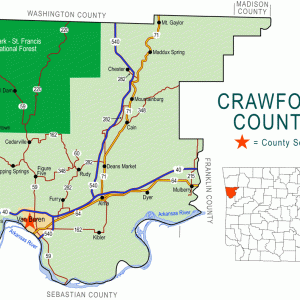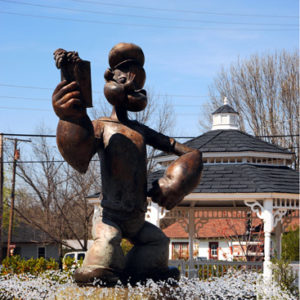calsfoundation@cals.org
Alma (Crawford County)
| Latitude and Longitude: | 35º28’40″N 094º13’18″W |
| Elevation: | 434 feet |
| Area: | 5.73 square miles (2020 Census) |
| Population: | 5,825 (2020 Census) |
| Incorporation Date: | January 7, 1874 |
Historical Population as per the U.S. Census:
|
1810 |
1820 |
1830 |
1840 |
1850 |
1860 |
1870 |
1880 |
1890 |
1900 |
|
– |
– |
– |
– |
– |
– |
– |
504 |
486 |
440 |
|
1910 |
1920 |
1930 |
1940 |
1950 |
1960 |
1970 |
1980 |
1990 |
2000 |
|
565 |
779 |
731 |
774 |
1,228 |
1,370 |
1,613 |
2,755 |
2,959 |
4,160 |
|
2010 |
2020 |
|
|
|
|
|
|
|
|
|
5,419 |
5,825 |
|
|
|
|
|
|
|
|
Alma has been Crawford County’s second-largest town since the town’s establishment around 1872. It became known nationally as the “Spinach Capital of the World” for its spinach-processing facility and has attracted national attention through the actions of outlaws Bonnie and Clyde and fundamentalist pastor Tony Alamo.
Before Alma became a settlement, Armstead “Ira” Smoot bought the land from the government on August 3, 1836. It was used mainly as farmland until Colonel Mathias F. Locke bought it in 1872. Locke built his house and a cotton gin on ten acres next to W. W. Smith’s drugstore and Smoot’s cabin. J. D. James kept a livery stable and a stage stand. In 1870, Alex W. Griffin had the first store and was postmaster. Alma was originally known as Gum Town because of its gum trees, and timber was one of the early industries in the area. It was incorporated in 1874, with W. P. Brown as mayor. Stories vary on how the town was named. Some say it was named for the sweetheart of Sam Daugherty, a nearby postmaster. Another version says suggestions were drawn from a hat.
The first school was a log house built around 1871. In 1872, a public hall was built for use as a church, school, and Masonic hall; overseers of the construction were Locke (president) and B. P. Renfroe (secretary of the building committee). Soon to follow were general merchandise, dry goods, and grocery stores. Other establishments sprang up, including a saloon, a steam mill, a cotton gin, and a saw and flouring mill in about 1874. The first church in the area was Alma Baptist Church of Christ (now First Baptist Church), established in August 1873. It was followed by the Presbyterian church founded on August 2, 1874; a Methodist church in 1875; and Alma Christian Church on October 13, 1877. Locke built the King Hotel, managed by a man named Mr. King. It was on the corner of Railroad Street and Fayetteville Avenue, but it burned down in about December 1884. The fire destroyed seven buildings at a loss of about $300,000. One private school served the district in 1884 and was run by Superintendent Lee Neal. By 1894, there were 142 white students in Alma schools and ninety-nine African-American students who were taught at a separate facility.
After 1876, when the Little Rock and Fort Smith Railroad was completed from Alma to points east, and a railroad depot was built, the town started showing great signs of growth, especially as the railroad helped foster the timber industry. The original roadway was half a mile south of its present place; again, Locke provided $1,500, and, through a land grant, a survey was secured, and the roadway was aligned with the tracks.
In 1877, forty-seven citizens of Alma filed a petition to make the town the county seat, arguing that its central locale served the county better than Van Buren. The issue came to a vote on July 10, 1877, which resulted in a 1,040 to 840 loss for Alma.
J. D. James had an annual business income of $120,000 and shipped about 3,000 bales of cotton a year. Cotton was the leading product, followed by timber from black walnut, locust, cedar, and sweet gum forests. Main cotton growers were Col. Locke and S. B. Locke, including a branch company of theirs, McKibben & Pape. Alma Canning and Evaporating Company was incorporated in August 1888 by about thirty stockholders and had $25,000 in stock. Its building was to be built in 1888, about 100 yards east of the railway depot, and was expected to draw a considerable fruit trade to Alma.
In 1877, M. L. Yeatman founded the Alma Herald, a newspaper that supported the Democratic Party. In 1879, a stock company, composed of prominent businessmen, bought the office, and George Thayer (of the Van Buren Argus) leased it; for two years, it was an independent Democratic paper under the name Crawford County Democrat. For the next eight years, the newspaper changed names and owners many times.
From about 1890 to 1920, the local agricultural economic base was founded upon cotton, strawberries, hay, and livestock. These slowly gave way to spinach, mustard greens, various beans, tomatoes, and other crops. Strawberry farmers were particularly hard hit by the spread of the crop to other parts of the country, such as Texas. This expansion, combined with easy shipping via railroad, drove down the prices. Some farmers found respite for a while planting potatoes.
In the early twentieth century, coal was being mined in Crawford County and natural gas was discovered. Alma sits on the eastern edge of the western Arkansas gas fields, which reach into Oklahoma and continue to provide a cheap source of energy for the area.
Famous outlaws Bonnie and Clyde, part of what was known as the Barrow Gang, committed a variety of crimes in Arkansas, including kidnapping and robbery, but their gravest crime occurred in Alma. On June 23, 1933, after robbing a grocery store in Fayetteville (Washington County), the gang ran into Alma marshal Henry D. Humphrey and Crawford County deputy sheriff Ansel “Red” Salyers on Highway 71 north of Alma. They killed Humphrey before escaping. The City Complex Building in Alma features a plaque commemorating the marshal.
Defying larger trends in Crawford County, Alma’s population actually increased during the World War II years. The presence of the canning company was likely the cause for this, as such companies across the nation received contracts to provide American soldiers with portable food.
Alma Canning Company was purchased by H. L. Hunt in 1961. Allen Canning Company, which canned over half the spinach consumed in the United States and was headquartered in Siloam Springs (Benton County), became the leading business in Alma. In 1987, Alma began calling itself the “Spinach Capital of the World.” The town erected a statue of cartoon character Popeye the Sailor, which stands in front of the Chamber of Commerce building, and began hosting an annual Spinach Festival. The festival announced in 2016 that it was celebrating its thirtieth year but ceased being held in subequent years. The town water tower was painted to resemble a can of spinach.
In 1974, independent fundamentalist pastor Tony Alamo established a compound in nearby Dyer (Crawford County) but soon began buying businesses in Alma, at one time owning as many as twenty-nine in the small town. His followers labored at the businesses for little pay. Though his Alamo Western Wear and Alamo Restaurant did attract visitors, many townspeople were dismayed at the undue influence he was exerting on local business and government. In 1991, federal agents raided the compound and arrested Alamo on various tax-related charges. Though freed in 1998, he did not reestablish his Dyer compound but instead moved to Fouke (Miller County). He was arrested again in 2008 after he was investigated for child abuse and child pornography, and died in federal custody in 2017.
Alma’s school district includes four schools: primary, intermediate, middle, and high school. Alma High School has the Alma Performing Arts Center, which is the Arkansas River Valley’s largest and busiest venue for the performing arts. The center has a state-of-the-art auditorium and hosts many shows throughout the year, from ballet to contemporary music. Alma school district enrollment in the 2010-11 school year was 3,437, from Kindergarten through twelfth grade. The Alma Airedales football, basketball, baseball, and track teams have won many county, district, and state titles.
The Alma Journal newspaper was published from 1995 to 2019.
In 1995, Alma annexed a swath of land that includes a championship golf course. Other attractions in the area include the Alma Aquatic Park and the annual Bargains Galore on 64, a yearly event featuring flea markets and other sales covering 160 miles of Highway 64 in Arkansas.
For additional information:
Alma Area Chamber of Commerce. https://almachamber.com/ (accessed February 16, 2023).
Eno, Clara B. History of Crawford County, Arkansas. Van Buren, AR: Press Argus, 1950.
Hopkins, Eula, and Wanda M. Gray. History of Crawford County, Arkansas. Van Buren, AR: Historical Preservation Association of Crawford County, 2001.
“Salute to Alma.” Special issue, The Heritage 7 (April 1964).
Debbie Walden Davis
Rudy, Arkansas
Staff of the CALS Encyclopedia of Arkansas
 Alma Drug Store and Opera House
Alma Drug Store and Opera House  Alma Street Scene
Alma Street Scene  Crawford County Map
Crawford County Map  Eagle Crest Golf Course
Eagle Crest Golf Course  Popeye Statue
Popeye Statue 




Tony Alamo’s wife Susan was actually the evangelist originally. I believe Tony sang. I remember seeing them pass our house daily going to their compound in Dyer. Susan had ties to the area and moved her ministry here for a number of years. The people of Alma don’t remember the Alamos favorably and would have preferred they settled somewhere else. Many visitors to the area actually thought Alma was named after them. We were Alma before the Alamos showed up.